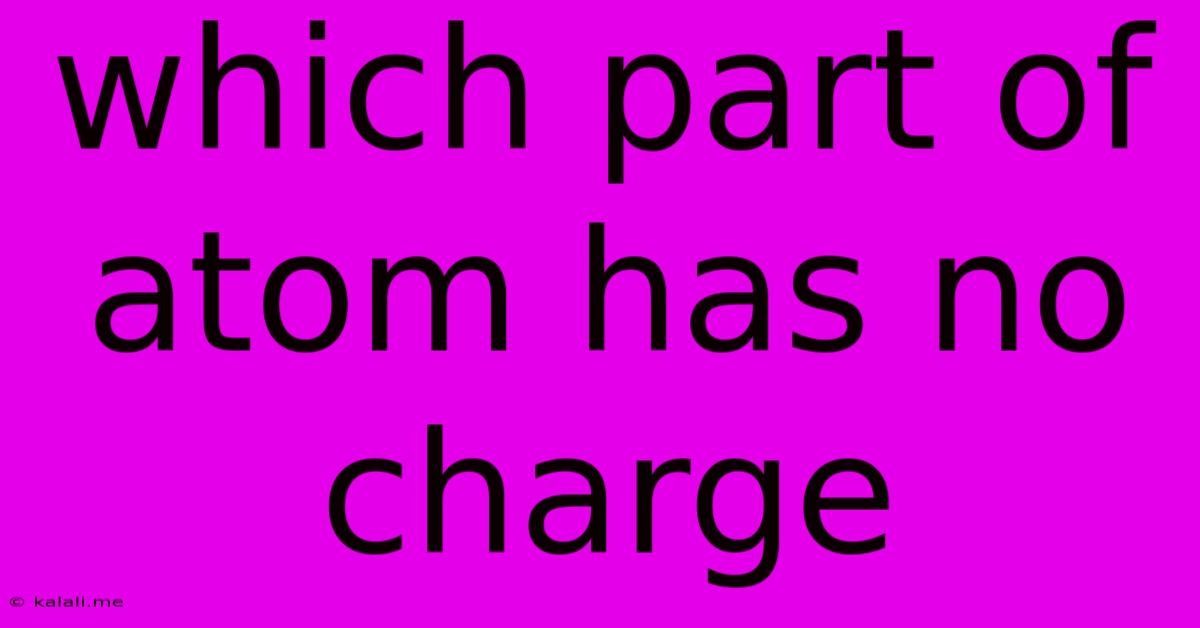Which Part Of Atom Has No Charge
Kalali
Jun 13, 2025 · 2 min read

Table of Contents
Which Part of an Atom Has No Charge? Understanding Neutrons
The question of which part of an atom has no charge leads us directly to the neutron. This subatomic particle resides within the atom's nucleus, alongside protons, and plays a crucial role in the atom's stability and properties. Understanding neutrons requires delving into the fundamental building blocks of matter.
This article will explore the characteristics of neutrons, comparing them to protons and electrons, and explaining their significance in atomic structure and nuclear reactions. We will also touch upon isotopes and their relevance to neutron numbers.
Protons, Neutrons, and Electrons: A Comparison
Atoms are composed of three fundamental subatomic particles:
-
Protons: These particles carry a positive (+) electrical charge and are found within the atom's nucleus. The number of protons determines the element's atomic number and defines its chemical properties.
-
Electrons: These particles possess a negative (-) electrical charge and orbit the nucleus in electron shells. They are significantly smaller than protons and neutrons and are responsible for chemical bonding and reactions.
-
Neutrons: Unlike protons and electrons, neutrons carry no electrical charge (neutral). They are located in the nucleus alongside protons, contributing to the atom's mass.
The key difference, and the answer to our initial question, is that neutrons are electrically neutral. This lack of charge differentiates them from the positively charged protons and negatively charged electrons.
The Role of Neutrons in Atomic Stability
Neutrons are essential for the stability of an atom's nucleus. The strong nuclear force binds protons and neutrons together, overcoming the electrostatic repulsion between the positively charged protons. In many atoms, the number of neutrons roughly equals or exceeds the number of protons. The ratio of neutrons to protons greatly influences the stability of an atom. Too many or too few neutrons can lead to radioactive isotopes.
Isotopes and Neutron Numbers
Isotopes are atoms of the same element that have the same number of protons but a different number of neutrons. This means they have the same atomic number but different mass numbers (protons + neutrons). Some isotopes are stable, while others are radioactive and undergo decay. The number of neutrons significantly affects the isotope's stability and its properties. For instance, Carbon-12 (6 protons, 6 neutrons) is stable, while Carbon-14 (6 protons, 8 neutrons) is radioactive.
Beyond the Basics: Neutron Interactions
Neutrons play a vital role in various nuclear processes, including nuclear fission and fusion. Their lack of charge allows them to penetrate atomic nuclei relatively easily, triggering these reactions. This characteristic is crucial in nuclear power generation and weaponry.
In summary, the part of an atom that has no charge is the neutron. Understanding its properties and function is fundamental to understanding atomic structure, nuclear reactions, and the behavior of matter at the subatomic level. The neutron's neutral charge is a defining characteristic that distinguishes it from protons and electrons and plays a key role in nuclear stability and reactivity.
Latest Posts
Latest Posts
-
How To Write 800 In Words
Jun 14, 2025
-
What Is The Last Step In The Communication Process
Jun 14, 2025
-
What Is The Resistance Of An Ideal Voltmeter
Jun 14, 2025
-
Which Of The Following Is A Decomposer
Jun 14, 2025
-
Which Of The Following Is An Example Of A Saprotroph
Jun 14, 2025
Related Post
Thank you for visiting our website which covers about Which Part Of Atom Has No Charge . We hope the information provided has been useful to you. Feel free to contact us if you have any questions or need further assistance. See you next time and don't miss to bookmark.